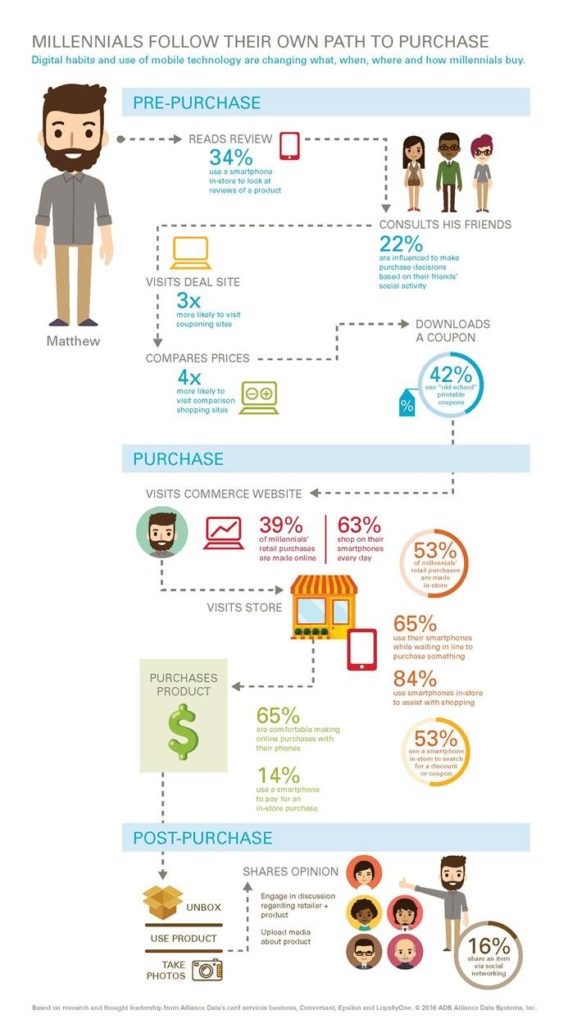What Millennials Want From Their Shopping Experience?
Life has evolved greatly over the last few decades economically. The boomers suffered a lot of poverty and struggled to make ends meet. Gen X were better off with making ends meet with little disposable income for luxuries. Then came the Millennials! Millennials are defined by Pew Research Center as people born from 1981 to 1996. Hence, millennials are 24 to 39 years old as of 2020.
At the same time, the shopping experience has evolved over the years. Our parents would go to neighbourhood mom and pop stores and give the shopkeeper a piece of paper with a list of items. Then came malls where they would visit various stores with a check list of items to be purchased. With the boom of the internet, smartphones and E-commerce, millennials, who by now were earning well with less financial liabilities as compared to their predecessors, started to buy things online. Approximately 80 million millennials live in the United States alone who spend approximately $600 billion. Their buying decisions are primarily influenced by social media. This requires brands to be present in brick-and-mortar stores as well as online.
Consumer loyalty becomes a challenge when one is spoilt for choices! Hence, brands came up with the idea of loyalty programs. This helped early movers. People elect to buy brands that engage with them as per their own tastes and preferences. Hence, brands started targeting shoppers on their social media pages. As the online and offline worlds started overlapping, it became challenging for brands to retain consumers for repeat purchases. Almost 90% of shoppers on a given day at a mall are window-shopping. They could end up buying a competitors’ product depending on how good their SEO/SEM strategies are. Hence, it is more important than ever for brands to do consumer engagement with Millennials digitally on their devices after they have window shopped their products at a retail store – this can be done using smart packaging. Malls aspiring to emulate e-stores and e-stores becoming more like malls!

Img source: cmo.adobe
Gone are the days when one ad campaign worked for everyone irrespective of their location, demographics and socio-cultural factors. Everyone wants personalization. Everyone wants to feel special. It’s not a ‘one size fits all’ anymore. Brands are now wanting to retarget their customers in their local language based on geography, special occasions and recent events. Customised customer engagement through smart packaging is a new revolution in the making!
According to an Accenture survey:
- Forty-one Percent of Millennials Said They Practice “showrooming” I.e. Seeing Merchandise at a Near-by Retail Store and Then Do an Online Search to Find the Cheapest Price, More Frequently Than They Did a Year Ago. This Shift is Due, in Part, to the Current High Smartphone Penetration Levels, Which Can Enable Customers to Search for an Item Easily, Even While in a Store.
- On Average, 89 Percent Said Getting Visibility into Real-time Product Availability Information Would Influence Their Shopping Options as to Which Stores They Would Visit Frequently, Which Meant Supply Chain Traceability Can Help in Consumer Sales Too.
- 78% of Millennials Are More Likely to Opt for a Brand with a Loyalty/reward Program Than a Brand Without a Loyalty Program.
- Smartphones Act as a Major Source of Connection to the Web for Millennials, with 89% of Them Using Their Devices to Connect, Vs. 45% Who Use Tablets, 75% Laptops and 37% Desktop Computers.
It’s an age of information overload. Attention spans are reducing day by day. The secret to staying on top of the millennials mind is something that brands are grappling with. Brands are spending huge sums on consumer engagement activities across online channels like Google, Facebook, Instagram promotions, etc. However, all they get to know is how many people clicked their ad. The end consumer remains invisible for the brand. Hence, measuring the RoI is almost impossible in these activities. Brands are looking for holistic ways to measure RoI in customer acquisition across omnii channels, which a few companies are doing with the help of smart packaging.
Another menace which bothers the high-spending millennial is fake products masquerading as genuine ones in the market. A buyer usually remains blissfully unaware of being fooled by counterfeits. This leads to a huge revenue loss for brands as well as the grave risk of having an adverse impact of the well-being of the consumer. Anti-counterfeiting measures by various brands have had limited success since it was restricted to physical changes in the packaging.
Counterfeiters and fraudsters found it easy to make physical changes to their packaging emulating the original pack. As per the Global brand counterfeiting report 2018 by research and markets, the amount of total counterfeiting globally had reached 1.2 trillion USD in 2017 and is expected to reach 1.82 trillion USD by the Year 2020. This shows the scale of counterfeiting globally across industries.
The only anti-counterfeiting option left for brands is a combination of physical and digital security measures. This again is being done through smart packaging. Brands are spending huge sums in anti-counterfeiting to protect their brand value built over years and they must invest in digital technologies to safeguard their brand value.
With technological progress has also come lifestyle changes and associated lifestyle diseases. Millennials are much more conscious of the contents and ingredients in products they consume. Brands now believe that showing the product journey to the Millennials will increase consumer trust. Companies are capturing various data points from the point the product was made till it reaches the end consumer, thus enabling track and trace. Few organic brands that are popular with Millennials have started showing the product journey to their customers by enabling supply chain traceability through such track and trace mechanisms to certify the organic origin of the product. This has helped them to differentiate them from their competitors and thus, retain their loyal consumer base through smart packaging.
Supply chain traceability is also helping brands to simplify and digitize their plant operations through track and trace. Hence, it’s a dual benefit which the companies get through smart packaging in terms of customized consumer engagement and supply chain optimization.
In summary, Millennials expect a seamless consumer engagement experience between shopping online and in a store. They are demanding transparency, personalization and provenance from the brands that they buy. Businesses need to ensure they deliver on this expectation in order to stay relevant to the Millennial consumer. Contact Sepio Products to crack the code on Millennials!


